#larousse (ratatouille)
Explore tagged Tumblr posts
Text
Mfs over here hating on Ajax while my ass is surprised he was part of our childhood all along. Bro played Larousse in ratatouille 😭😭
12 notes
·
View notes
Photo

Larousse
3 notes
·
View notes
Note
Who is your favorite chef at the restaurant
“I don’t have a favorite.”
Horst is lying his best buddy is Larousse

11 notes
·
View notes
Photo

22 notes
·
View notes
Text

yuh
9 notes
·
View notes
Text
Rasain Makanan Lewat Tulisan, Emang Bisa?

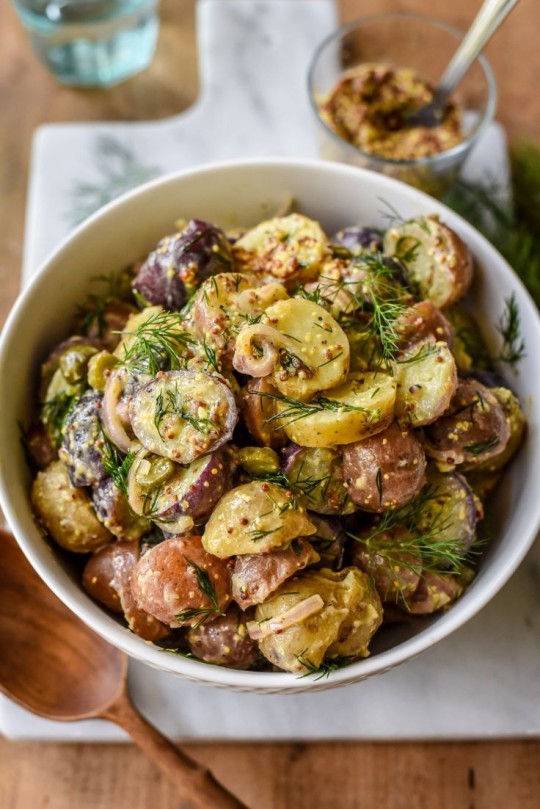


Pernahkah kalian menonton film Ratatouille? Apa yang kalian ingat dari film ini? Tikus memasak? Keindahan kota Paris? Atau makanannya yang mengunggah selera? Kalau saya sih yang diingat itu adalah seorang kritikus makanan yang muncul untuk menilai makanan si koki tikus ini. Dalam scene terakhir film ini, digambarkan sang kritikus yang menuliskan ulasannya ke dalam sebuah tulisan yang selanjutnya di publish untuk khalayak ramai. Tulisan ini dikenal sebagai “food writing” atau tulisan tentang makanan.
Kata “food writing” sendiri baru populer di tahun 1990-an, padahal tulisan tentang makanan ditemukan pertama kali pada abad 14, yaitu buku berjudul “Le Viandier” yang merupakan buku resep asal Prancis. Selanjutnya pada abad 18 juga ditemukan buku berjudul “Larousse Gastronomique” karya Jean Anthelme Brillat-Savarin, buku ini dikenal sebagai food writing klasik yang menjadi awal dari food writing masa sekarang.
Popularitas food writing di Indonesia tidaklah se booming seperti di Prancis ataupun negara barat lainnya. Seperti yang dibahas dalam webinar Indonesia Writers Festival 2021 oleh IDN Times dengan tajuk Culinary Story Teller, Mengolah Rasa Menjadi Aksara pada Kamis, 28 Oktober 2021, Kevindra Soemarti, narasumber dalam webinar ini, mengungkapkan bahwa saat ia mulai menulis tentang makanan di tahun 2014, belum banyak karya food writing yang beredar di Indonesia. Hal ini juga bisa didasari dari sedikitnya kritikus makanan yang ada di Indonesia.
Namun, Kak Kevin, begitu ia dipanggil, cukup senang dengan perkembangan minat food writing di Indonesia dalam 2 hingga 3 tahun belakangan. Menurutnya hal ini begitu penting dikarenakan food writing merupakan salah satu pilar dari art journalism. Selain itu, ia juga berpendapat Indonesia memiliki banyak keunikan tersendiri dalam setiap kulinernya sehingga membuat Indonesia menjadi lapangan luas untuk para food writer di masa mendatang.
Webinar yang diadakan oleh IDN Times dalam acara Indonesia Writers Festival menawarkan topik-topik yang sangat bermanfaat untuk belajar mengembangkan tulisan kita. Dari sekian topik yang ditawarkan, topik mengenai food writing sangatlah menarik karena di Indonesia sendiri culinary journalism atau tulisan tentang makanan belum umum dikalangan masyarakat. Sehingga webinar ini sungguh membantu membuka wawasan baru bagi masyarakat bahwa jurnalisme tidak hanya sebatas berita seperti di koran loh, tapi makanan pun merupakan bagian dari jurnalisme itu. Siapa yang menyangka kalau hal sesimpel makanan memiliki peran lebih dari hanya sebagai pemenuh nafsu lapar.
Narasumber yang diundang dalam topik ini juga tak kalah menarik perhatian. Jika biasanya webinar itu identik dengan pembicara yang baku, monoton, dan membosankan, tapi Kak Kevindra Soemarti menyampaikan materinya dengan cara yang welcoming dan asik. Pembawaannya yang santai makin membuat betah untuk mendengarkan webinar ini. Informasi-informasi yang ia berikan sangatlah insightful dan dikemas secara apik sehingga para pendengarnya dapat memahaminya dengan mudah. Adanya sesi tanya jawab juga menambah kesan engaging dalam webinar ini.
Kak Kevin membagikan fakta dan tips menarik yang berkaitan dengan menulis tulisan kuliner. Kak Kevin berpesan kepada para pemula dalam dunia food writing, kalau menulis makanan itu tidak boleh asal icip lalu tulis, tetapi kita juga butuh data, butuh riset. Agar mempermudah riset, kita bisa mulai dari hal yang kita suka, seperti makanan asal daerah kita atau restoran yang sering kita kunjungi. Dengan begitu, diharapkan kita bisa menulis dengan passion yang kuat dan menikmati melakukan setiap prosesnya.
Riset adalah faktor penghambat terkuat penulis muda untuk memulai tulisannya. Padahal, riset itu wajib loh dalam dunia food writing karena food writing tidaklah sebatas pada reviewmakanan enak ato tidak enak, tetapi juga dibutuhkan asal-usul daerahnya, bahan bakunya, bahkan kalau perlu sampai penciptanya. Kak Kevin memaparkan adanya empat pilar yang harus dipahami dalam dunia food writing, yaitu penulisan resep, food feature, restaurant criticism, dan food literature. Keempat pilar ini memiliki cara riset yang berbeda-beda. Walau begitu metode yang paling dasar dalam melakukan risetnya adalah dengan metode 5W1H. “Dari 5W1H ini saja dapat menjadi landasan riset yang sederhana, namun dapat memperkaya tulisannya.” itulah perkataan Kak Kevin tentang metode riset di dunia food writing.
Kak Kevin juga bercerita bagaimana riset membantunya dalam mengkritik makanan. Waktu itu, ia diharuskan untuk menulis tentang sebuah restoran Prancis. Ia tidak terlalu familiar dengan makanan Prancis pada saat itu. Akhirnya ia mencari siapa kokinya, asalnya darimana, kira-kira menu apa yang disajikan jika pada saat itu musim gugur, musim panas, atau yang lainnya. Hingga saat ia tiba di restoran tersebut, lalu membuka menunya ia sudah mempunyai bayangan tentang makanan-makanan yang ada. Kak Kevin juga berpesan untuk jangan pernah malu untuk bertanya. Kita bisa bertanya kepada pramusaji restoran, pemiliknya, kokinya, atau yang lebih dekat adalah orang yang sedang menyantap makanan di meja sebelah kita. “Bertanyalah hingga kalian menjadi ensiklopedia berjalan.” begitu yang ia katakan.
Selanjutnya Kak Kevin juga membahas apakah untuk masuk dunia food writing harus bisa memasak? Jawabannya adalah tidak juga. Namun, ia berkata akan lebih baik jika kita juga bisa memasak agar bisa lebih peka dalam mengulas tentang makanan. Ia juga menambahkan kalau kita belajar memasak pelan-pelan sambil menulis nanti kemampuan kita untuk mengerti masakan akan membuat kita lebih memerhatikan makanan yang akan kita santap. Sehingga, akan sangat membantu dalam proses memindahkan makanan ke dalam tulisan kita.
Dalam webinar ini juga dibahas tentang subjektivitas dalam penulisan makanan. Kak Kevin menegaskan bahwa subjektivitas dalam makanan itu berbahaya. Selayaknya jurnalisme pada umumnya, kita harus sebisa mungkin tetap objektif dalam mengkaji suatu objek atau peristiwa. Seorang kritikus makanan tidak boleh memakai preferensi pribadi dalam tulisannya. Kak Kevin berpesan saat kita ingin mencicipi suatu makanan jangan datang dengan ekspektasi, tapi datanglah seperti kanvas putih. Biarlah pengalaman menyantap makanan saat itu mewarnai kanvas putih tadi. Lagipula, kalau ekspetasi kita tak sesuai realita kan jadi membuat mood turun saat menuliskannya.
Satu hal yang sangat membekas saat selesai mendengarkan webinar ini adalah tentang kata ‘enak’ dan ‘tidak enak’. Menurut saya dua kata itu adalah kata yang abstrak. Tidak ada kepastian dalam maknanya. Pemikiran saya ternyata sejalan dengan Kak Kevin yang mengatakan bahwa dalam menulis makanan, jika makanan itu enak maka jelaskan seperti apa rasanya apakah manis, asin, ataukah pedas. Dengan begitu para pembaca yang membaca tulisan kita dapat ikut merasakan makanan yang kita tulis saat itu. Mereka dapat ikut merasakan bagaimana rasa makanan yang entahlah, bisa pedas, asin, asam, gurih, ataupun manis. Lalu mereka akan merasa penasaran dengan makanannya dan pergi untuk membelinya. Wah, strategi marketing yang bagus bukan.
Oleh: Shafira Damayanti
(21/479725/SP/30359)
2 notes
·
View notes
Note
idk if you're even into this anymore but pls fill me in on your extensive ratatouille lore I'm fascinated.
am I even interested anymore ... my dude. the intense love that I have for Ratatouille will never die, so you’re in luck. I honestly don’t even know where to begin. ASK ME SPECIFIC QUESTIONS CUZ I WANT TO GUSH ABOUT THIS AGUHGH
To start, here’s a post I made a while back about some random headcanons.
One of the biggest speculations I have of the film overall is that Skinner AND some of the chefs (namely Larousse and Horst, who both interact with Skinner during the scene where Alfredo is introduced) already knew about Alfredo and his relation to Gusteau, but it was kind of an unspoken secret that no one talked about. Something that Skinner hoped everyone had forgotten about. The film takes place only a few weeks before the expiration of Gusteau’s will, which would revert his estate to Skinner if an heir did not appear. And then, coincidentally before this happens, an heir appears seemingly out of nowhere! Alfredo probably received instruction from his mother Renata to apply for a job at Gusteau’s, and she would send him with the letter to Skinner. But we don’t know how long it had been since her death and the events of the movie, so not only is the timing suspicious, but why is it that the chefs had “already hired” Alfredo as a garbage boy before Skinner could actually give approval? Is it because they already knew Skinner would send him away without consideration? That’s exactly what he tried to do before Horst dropped the news about Alfredo’s hire.
Also, WHY was Skinner SO threatened by Alfredo “trying” to cook? I put that in quotations because Alfredo wasn’t even TRYING, he was just attempting to fix his mistake of spilling almost an entire pot of soup onto the floor. I mean yeah, you’re a restaurant with a huge reputation that is on the line, one mistake from a stupid kid could sink the whole ship. But beyond that, he allowed Alfredo to continue cooking only because Colette pushed that issue. I truly believe he felt Alfredo was as talented as Gusteau, and the whole point of him showing up to the restaurant was to dismantle Skinner’s career. Skinner is so blinded by this idea of conspiracy that he doesn’t realize Alfredo simply was in the right place at the right time and had no idea of anything going on, and his intentions were as simple as taking the job to have stable income and nothing more.
this could get REALLY LONG just on this one idea so if anyone has specific things they want me to talk about my speculations on, PLEASE TELL ME this is like my favorite thing to do is talk about Ratatouille
13 notes
·
View notes
Text

RATATOUILLE
country of origin: France 🇫🇷
Ratatouille, now here is a famous dish I’m sure everyone remembers. The dish was featured in the Pixar film of the same name, it was about a rat who had dreams of becoming a chef. The word was derived from the Occitan ratatolha and is related to the French ratouiller and tatouiller meaning “to stir up”. The ratatouille’s foundation is the tomato then mixed with sauteed garlic, onion, zucchini, eggplant, bell pepper, marjoram, fennel and basil.
The Larousse Gastronomique claims "according to the purists, the different vegetables should be cooked separately, then combined and cooked slowly together until they attain a smooth, creamy consistency", so each vegetable will taste truly of itself.
written by: HANZKKI ARCAYA
1 note
·
View note
Text
back to the hyperanalystic bullshit
@vivaciousarcanist
You’re basing your analysis on the implication that Boyardee is dead, not merely “historically important.” If the film is set in 1962, then Boiardi’s 1953 commercial would be reasonably contemporary and an easy reference for a food critic to make.
Thunderhead was still a super, even if supers were illegal. He could have been moonlighting, just as Mr. Incredible and Frozone were. Remember that Mr. Incredible was late to his wedding because he was supering, in costume, while supers were illegal.
If Ratatouille is set between 2003 and 2018, how do you explain the complete lack of computer technology, the Paris architecture, Colette’s hair, Larousse’s gun-running, B&W TVs, product packaging, and the motorcycle?
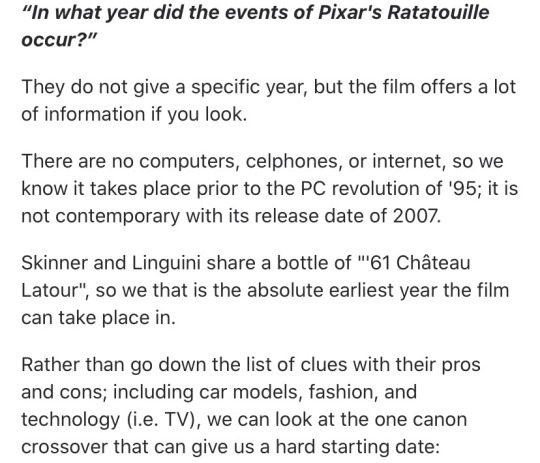
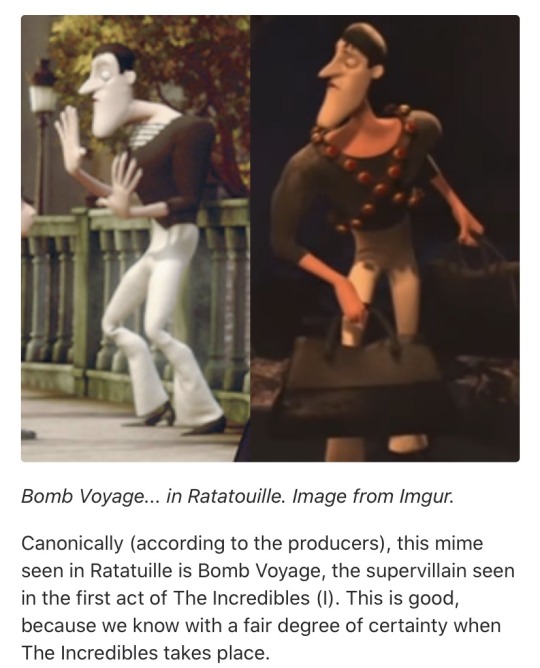
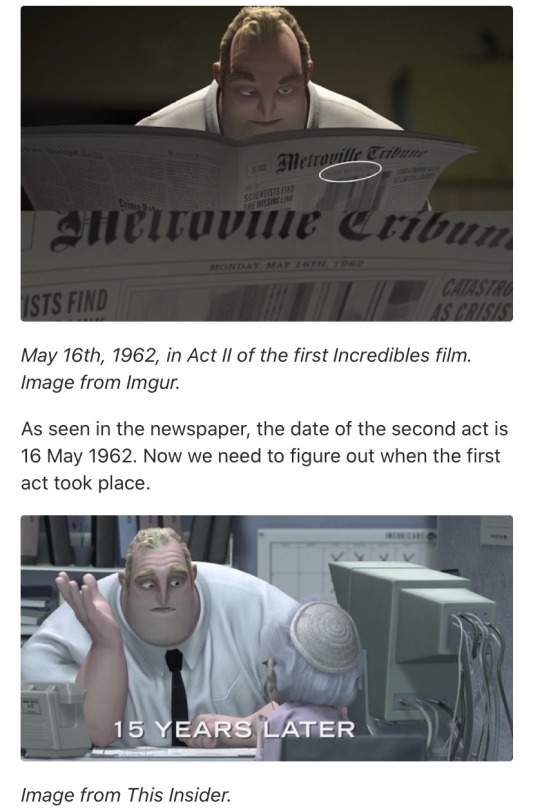

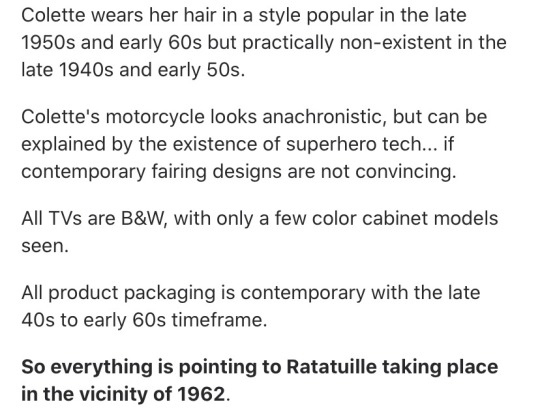
This is the level of hyperanalystic bullshit I live for
147K notes
·
View notes
Text

A classic dish of the south of France is ratatouille niçoise. It’s summer on a plate. It’s also a great dish for entertaining because it’s even better the second day, so it’s ideal to make ahead. Nice gets credit for its creation but it’s a dish common to all of Occitanie, the broad swath of southern France.
My friend Christine put it on the menu for our cooking class, along with grilled thyme lamb chops, which I’ll also include here.

Remember, for a same-day dinner, we made the desserts first, starting with the crème catalan, then the baba au rhum. Once the baba was cooling, we tackled the ratatouille, or rata, as the French like to say. It’s very French to cut off words to two syllables: Coca-Cola becomes Coca (not Coke); McDonald’s is known as “MacDo”; spaghetti bolognaise is called “bolo”; Carcassonne is called “Carca”….
Even first names get shortened to two syllables (often one syllable repeated twice) to form a nickname: Laurence is Lolo; Louis is Loulou; Alphonse is Fonfon; Georges or Joseph becomes Jojo; Julien is Juju. Now that I think about it, all those are male names. Though I know a Brigitte who goes by Bibi. Female names often get -ou at the end: Michelle becomes Michou (sounds like mishoo); Giselle is Gisou. And there are another range of nicknames that also use the repeated two-syllable style: uncle (officially it’s oncle, but familiarly it’s tonton); I know a Tintin… But there are exceptions: a son (fils) may be affectionally referred to as fiston. Aunt (tante) becomes tatie. Grandmother (grand-mère) is more likely called mamie.
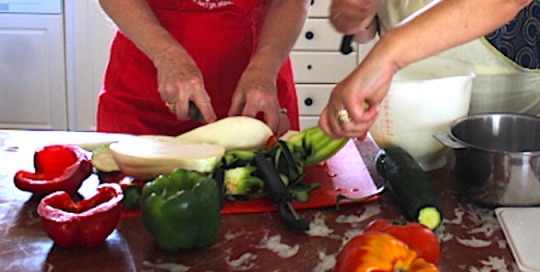
Back to the rata.
Here’s what you need (easy to remember, it’s 3 of everything):
olive oil
3 onions, minced
3 small eggplants, (large) dice. Purple ones should be peeled; white ones have a thinner, milder skin that can be left on.
3 zucchini, peeled and diced
3 tomatoes, peeled (blanche first) and cut into large chunks
1 green pepper, diced
1 red pepper, diced
1 yellow pepper, diced
salt, pepper, thyme, and a bay leaf or two
Cover the bottom of a large, heavy pan with a coat of olive oil. Cook the onions over medium heat, stirring often, until they soften.
Add the eggplant, and continue to stir until it softens.

Add the zucchini. Then the peppers. Then the tomato and spices.
Let it cook until everything has softened up. Don’t put on the lid or you will end up with a lot of juice.
Serve hot, cold or lukewarm.
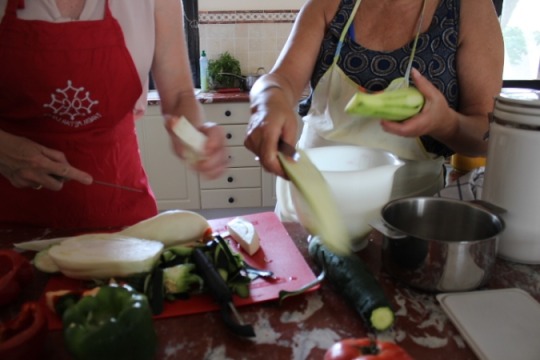
What I like about rata is that there are no mistakes (unless you really burn it or you overcook the vegetables into mush–one of the Carnivore’s sharpest insults for a mix of overcooked food is “ratatouille”) and lots of room for variation.
To reduce the juice, I like to cook everything quickly and separately over high heat, so the outsides of the zucchini and eggplants, especially, brown, but the vegetables aren’t too cooked. They get added in turn to a mixing bowl and then heated together before serving. Or not heated. I learned, while writing this, that cooking the vegetables separately is the method that the French bible of cuisine, Larousse Gastronomique, suggests, though it says to cook the mix about 20 minutes in the oven. Putting the dish in the oven is a good way to avoid scorching the bottom, but I’d rather just keep it stovetop and not heat up the kitchen.
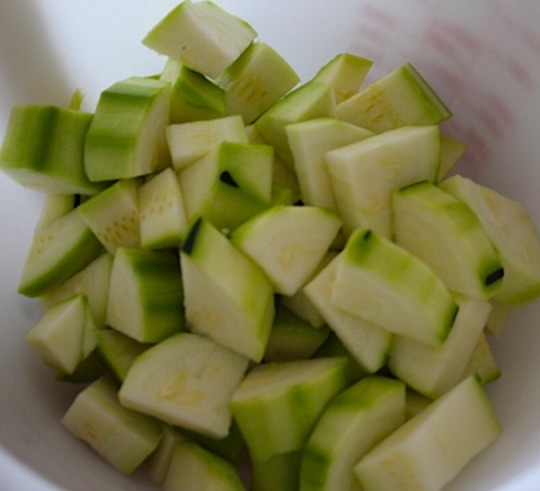
I rarely peel vegetables–out of laziness and also for the added nutrition. I also add plenty of garlic–three or four cloves. Sometimes I use herbes de provence, a mix of thyme, marjoram, rosemary, basil and savory, which we tend to put into almost everything. Other times, I use fresh herbs from the garden–thyme, rosemary, basil.
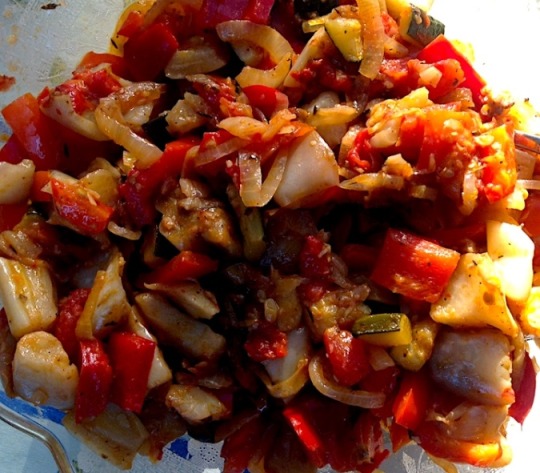
Rata is a good way to eat the rainbow. Consuming a variety of fruits and vegetables gives you different nutrients, since the colors are linked to different disease-fighting chemicals, called phytochemicals.
Another plus for ratatouille: leftovers are great, and you can even put it on pasta or rice for a vegetarian meal.
We served it with provençale tomatoes (recipe coming soon) and thyme lamb chops.
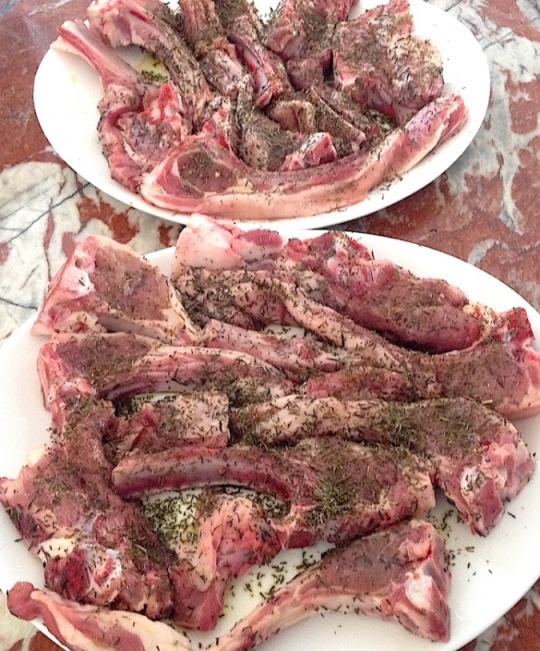
For the lamb chops:
Cut off the egregious hunks of fat. They will just cause your grill to flame up.
Brush both sides with a little olive oil so the thyme sticks to the chops and so the chops don’t stick to the grill. Sprinkle with thyme, salt and pepper on both sides.
Cook to taste on your grill. The Carnivore swears by wood charcoal, but we won’t get judgy if you use gas.
Bon appétit!
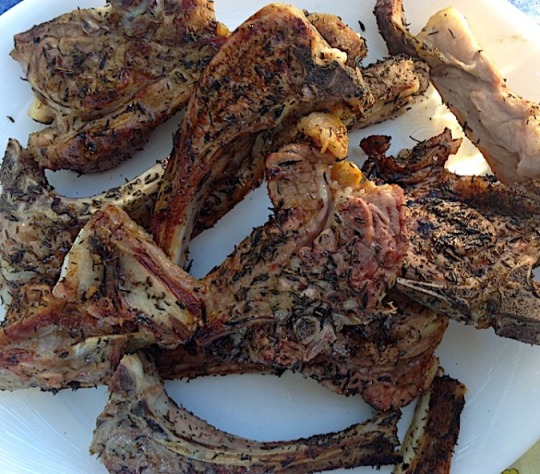
Ratatouille Niçoise A classic dish of the south of France is ratatouille niçoise. It's summer on a plate. It's also a great dish for entertaining because it's even better the second day, so it's ideal to make ahead.
0 notes
Text
Okay I just want to point out how nice Larousse is to Linguini in Ratatouille, like, he gives him genuine smiles, offers him a job behind skinners back, was he like secretly close to His family or something? Cause that like...I love that, I love underrated characters too much
1 note
·
View note
Photo

15 notes
·
View notes
Text
alright
gonna say it
these two would be cute together

17 notes
·
View notes
Text
alright niche au for ratatouille
Colette doesn’t exist because she’s terrible and Linguini deserves better
and by better i mean two parental/uncle figures to fill the adult orphan void in his heart
who, u may be wondering
Horst + Larousse o’course
also Linguini would become punk because i said so
5 notes
·
View notes
Photo
When you walk into the wrong classroom

22 notes
·
View notes
Photo
When you lied in the job application and actually got the job

#ratatouille#caption this#linguini#larousse#horst#chef horst#chef horst kerr#sous chef horst#sous chef horst kerr#ratatouille horst#my husband#German Gordon ramsay#horst kerr
15 notes
·
View notes